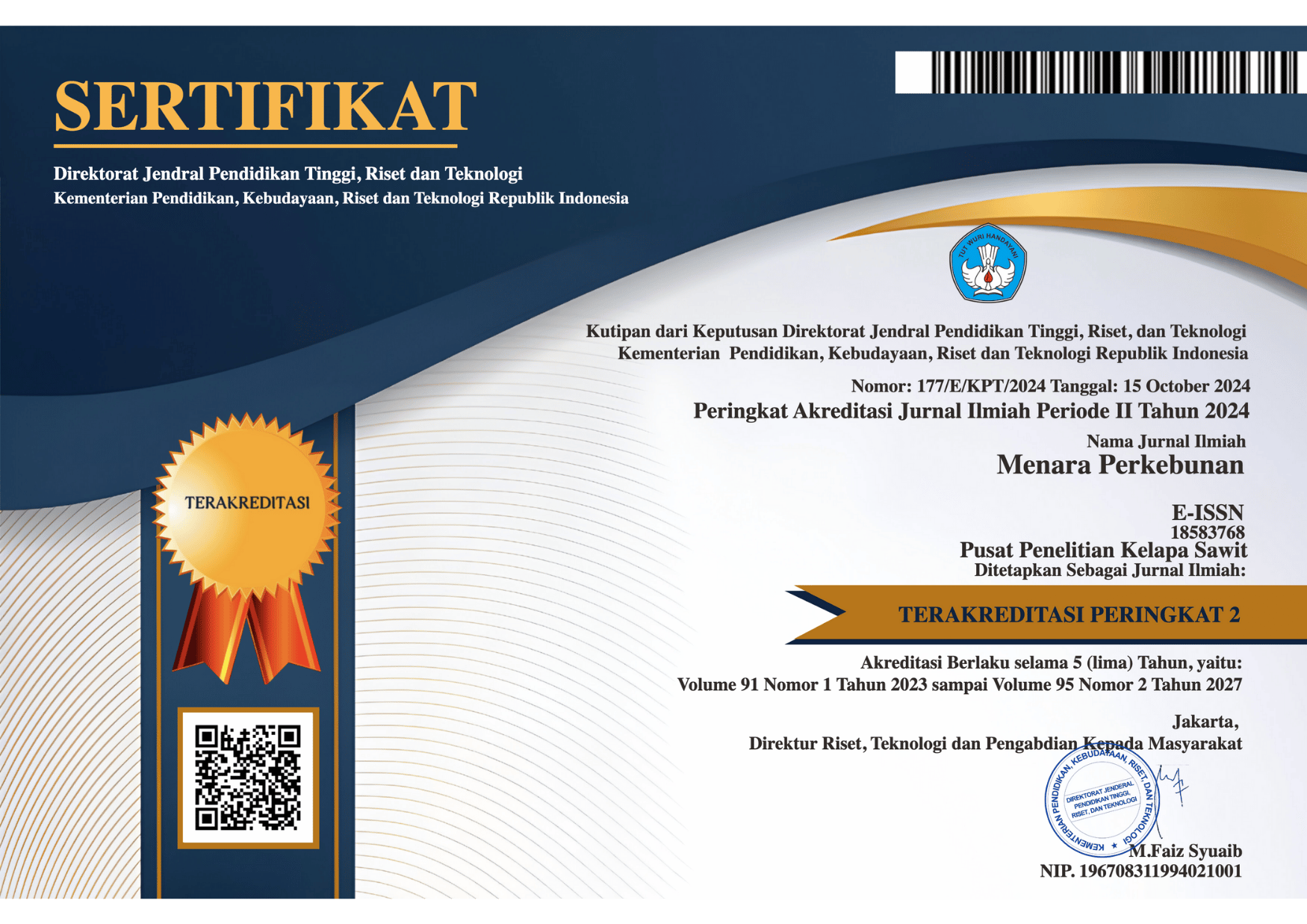Analisis sekuen DNA daerah 5’–EGAD1 dari buah kelapa sawit normal dan abnormal hasil kultur jaringan Analysis of DNA sequences of the 5’-flanking EGAD1 from normal and abnormal fruit from tissue culture derived oil palm
DOI:
https://doi.org/10.22302/iribb.jur.mp.v78i2.63Keywords:
5’-flanking EGAD1, mantled fruit, RT-PCR, molecular marker, Elaeis guineensisAbstract
Abstract
Clonal propagation of oil palm through in vitro culture is a potential approach to fulfill the demand of oil palm elite planting materials. However, the incidence of floral abnormality known as “Mantled” from oil palm derived from in vitro culture which was around 5%-80%, hampered the commercialization of this clonal oil palm planting materials. EGAD1, a defensin gene detected in oil palm, was reported to be expressed in significantlyhigher in callus cultures initiated from mantledpalms compared with those obtained from normally flowering individuals. As a part of research work to develop a molecular marker for early detection of abnormality in oil palm derived tissue culture, this research was aimed to isolate and analyze the sequences of the 5’ flanking region of EGAD1 gene of the normal and mantled oil palm. The research was initiated by expression analysis of EGAD1 at the flower and fruit of normal and mantled phenotypes, followed by isolation of the 5’ flanking region of the gene by genomic PCR. The sequences of PCR product were then aligned by ClustalW from BioEdit. The results showed that mantled phenotype of flower and fruit accumulated mRNA EGAD1 higher than that of normal phenotype. Differences between the two DNA sequences were detected at the bases of 141, 188 dan 198, which implied on the differences of the restriction map. These differences give a possibility to develop a molecular marker for detection of the abnormality on oil palm derived from tissue culture, based on the RFLP technique.
Abstrak
Perbanyakan kelapa sawit melalui kultur jaringan merupakan salah satu pendekatan yang sangat potensial untuk memenuhi permintaan bibit unggul kelapa sawit. Namun terjadinya abnormalitas pembungaan yang dikenal sebagai bunga mantled pada tanaman kelapa sawit hasil kultur jaringan, menjadi hambatan komersialisasi bibit tersebut. Gen EGAD1, yaitu gen defensin yang diidentifikasi merupakan salah satu gen pada kelapa sawit yang ekspresinya dilaporkan jauh lebih tinggi pada kalus yang diinduksi dari tanaman kelapa sawit abnormal dibandingkan dengan pada kalus asal kelapa sawit normal. Sebagai bagian dari usaha pengembangan pelacak molekuler untuk deteksi dini abnormalitas kelapa sawit hasil kultur jaringan, penelitian ini bertujuan untuk mengisolasi dan menganalisis perbedaan sekuen DNA daerah 5’ flanking gen EGAD1 dari buah normal dan buah mantled. Penelitian dimulai dengan analisis ekspresi EGAD1 pada jaringan bunga dan buah normal dan mantled dengan RT- PCR, dilanjutkan dengan isolasi daerah 5’flanking EGAD1 dengan PCR genomik. Sekuen produk PCR kemudian disejajarkan melalui ClustalW BioEdit. Hasil penelitian menunjukkan bahwa bunga dan buah mantled mengakumulasikan mRNA EGAD1 lebih tinggi dibanding-kan dengan bunga dan buah normal. Terdapat perbedaan sekuen DNA pada daerah 5’ flanking dari gen tersebut antara buah normal dengan buah mantel, yaitu pada basa ke-141, 188 dan 198, yang berimplikasi pada perbedaan peta restriksi kedua sekuen. Hal ini memberi peluang untuk pengembangan suatu pelacak deteksi abnormalitas pada tanaman kelapa sawit hasil kultur jaringan, yang berbasis pada teknik RFLP.
Downloads
Downloads
Submitted
Accepted
Published
How to Cite
Issue
Section
License
Copyright (c) 2016 Jurnal Menara Perkebunan

This work is licensed under a Creative Commons Attribution 4.0 International License.
Authors retain copyright and grant the journal right of first publication with the work simultaneously licensed under a Creative Commons Attribution License that allows others to share the work with an acknowledgement of the work's authorship and initial publication in this journal.













